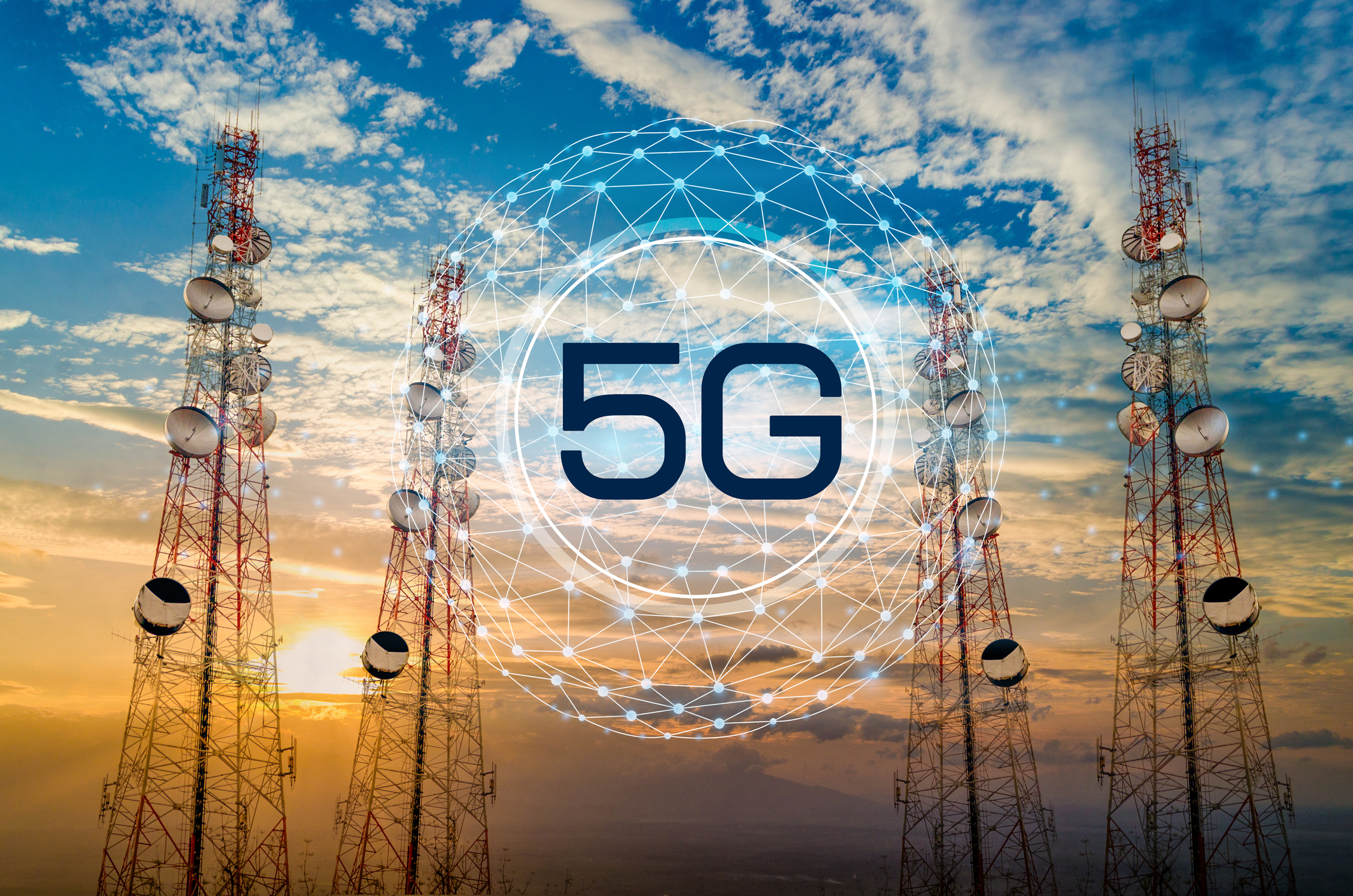5G Non-terrestrial Networks: Connectivity Beyond Borders
In the constantly developing environment of communication technology, evolution in 5G technology plays an important role. With this prospect, satellites have played a significant role, as the 3GPP for Release 17 (R17) has introduced new 5G New Radio (NR) standardization features to support satellite-based communication. This new feature of satellite communication in the 3GPP standard is known as 5G Non-terrestrial Networks (NTNs). The article discloses the core of 5G Non-terrestrial Networks and their architecture, service provisioning methodologies, challenges faced while deploying 5G Non-terrestrial Networks and their solutions, and the market adoption of 5G Non-terrestrial Networks.
What are 5G Non-terrestrial Networks (NTN)?
Based on the new radio (NR) technology introduced by 3GPP in Release 17, the Non-terrestrial Networks is a satellite-terminal direct wireless communication technology. The 5G Non-terrestrial Networks operate above the earth’s surface, involving high altitude platforms (HAPS), unmanned aerial vehicles (UAVs), and satellites at low earth orbit (LEO), medium earth orbit (MEO), and geostationary orbit (GEO). 5G Non-terrestrial Network technology enables the space-air-ground integrated network to provide network services to global users by satisfying their need for anywhere-anytime connections by offering extensive coverage while providing continuous service availability and scalability. It further satisfies the future network requirements by ensuring connectivity at all times, domains, and spaces.
What are the Prominent Use Cases of 5G NTN?
On the broader level, the 5G NTN use cases are divided into three categories. The first is service continuity to provide NTN access, which is impossible through terrestrial networks. The second is service ubiquity, which improves the NTN availability in disaster areas with a temporary outage or destruction of a terrestrial network. The last is service scalability, which lets traffic offload from terrestrial networks. Some of the prominent use cases are shown in the figure below.
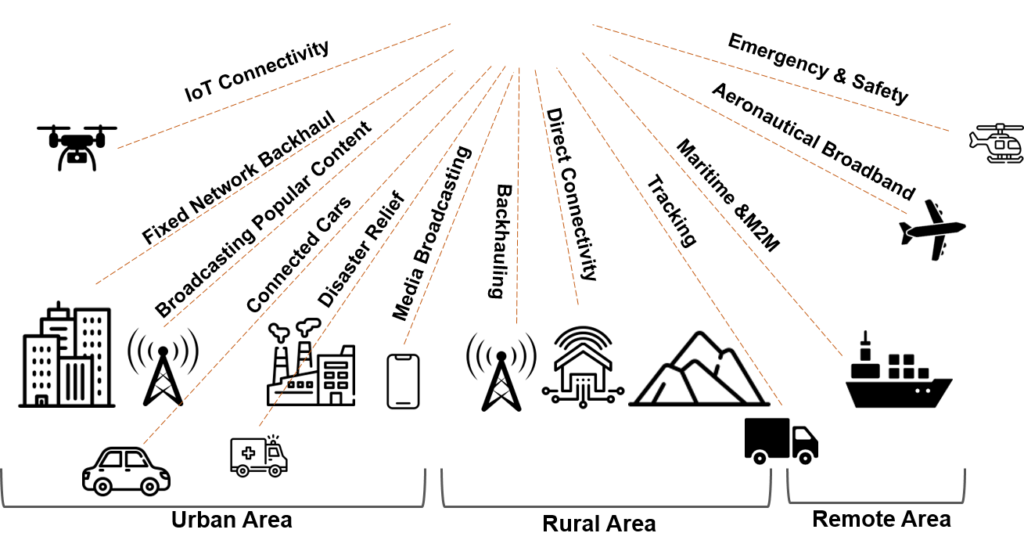
Figure 1: 5G NTN Use Cases
What is the 5G Non-terrestrial Networks Architecture?
Within the 5G Non-terrestrial Networks, to overcome the 5G connectivity challenges with terrestrial user equipment, such as long propagation delays, Doppler shifts associated with the user equipment (UE) moving at high speed, and others, the 3GPP Release 17 has proposed an architecture that will resolve these challenges. The 5G Non-terrestrial Networks enable data connectivity beyond this terrestrial cellular tower coverage, allowing UEs to be connected always.
The 3GPP has further proposed two service provisioning methodologies for the 5G Non-terrestrial Networks to resolve these challenges. They are briefly described below:
- IOT—Non-terrestrial Networks: These are designed for low data rates and low complexity services such as non-real-time data exchange in agriculture, logistics, transportation, or industries in remote areas. They also provide global coverage over sea, air, and land where terrestrial networks may not be deployed. Some use cases of IoT—Non-terrestrial Networks are safety and messaging, utility meters, tracking logistics, and others.
- NR—Non-terrestrial Networks: These are designed for higher data-rate connections to directly link smartphones and other 5G devices using 5G RedCap in non-terrestrial locations. Some use cases involve voice and video calls, media streaming, mobile broadband service to smartphones and embedded devices, fixed wireless access, automotive and mobile computing connectivity, and satellite backhaul for cell towers in remote locations.
The figure below describes the basic 5G Non-terrestrial Network architecture with two network links. The first is a service link between the satellite and the user’s terminal or ground station. The second is a feeder link between the satellite and the Earth station or Non-terrestrial Network gateway.
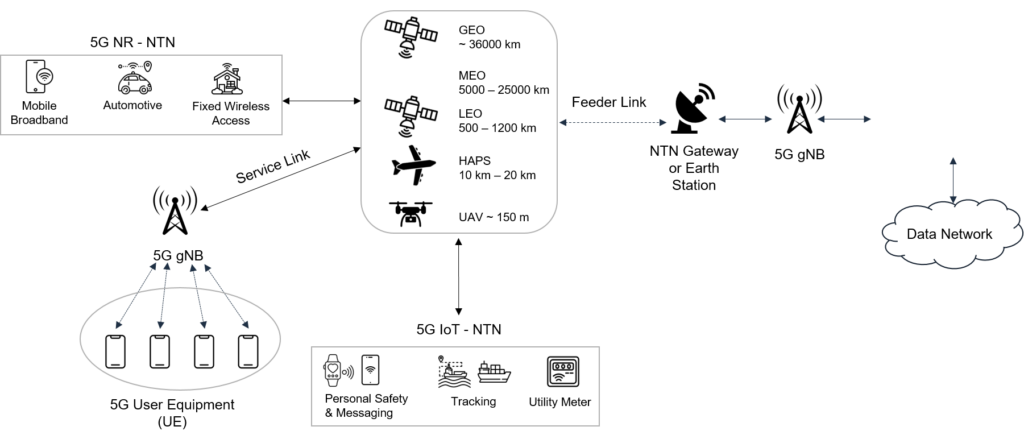
Figure 2: Basic 5G Non-terrestrial Network Architecture
Apart from the network links, the Non-terrestrial Network architecture comprises user equipment (UE), non-terrestrial elements (NTE) such as satellites/HAPS/ drones, earth stations or Non-terrestrial Network gateway, 5G base station (gNB), and other data networks.
The 3GPP Standards define two possible architecture combinations for 5G Non-terrestrial Networks depending on the position of the gNB functionalities:
- Transparent Mode NTN Architecture: In transparent architecture, the 5G gNB is positioned at the ground, and thus, as shown in the figure below, after the NTN gateway or earth station. The NTN is transparent to the signals sent by the UE, which is again retransmitted to the NTN gateway without any onboard processing, i.e., no data processing occurs in the satellite. However, the NTE acts as a repeater and performs frequency conversion, RF filtering, and power conversion. Further, the 5G gNB is connected to the 5G NGC to transmit the signal to the external data networks. Due to its overall functionality, only Release 17 supports this architecture
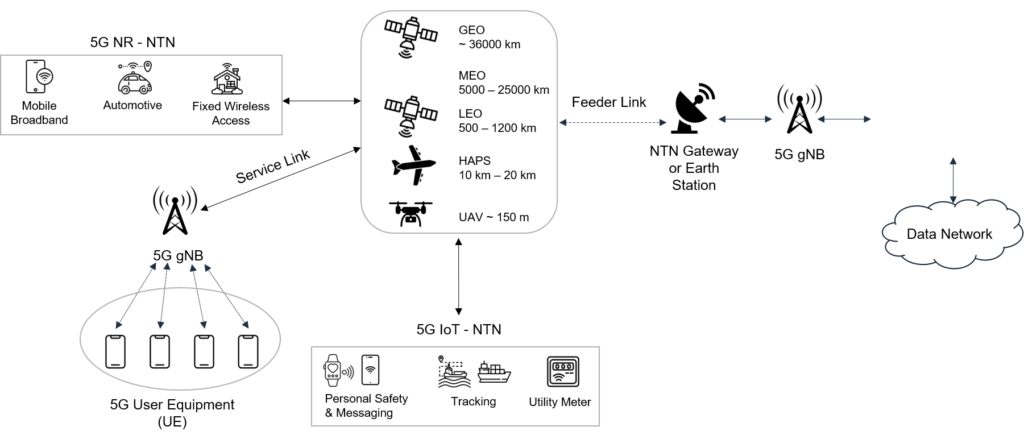
Figure 3: Transparent Mode based 5G NTN Architecture
- Regenerative Mode NTN Architecture: As shown in the figure below, this architecture shares similarities with transparent architecture but functions differently, as the 5G base station (gNB) is positioned inside the NTE. The architecture improves the NTN performance, as the data processing, such as modulation/demodulation, encoding/decoding, and frequency/power conversion, is done in the NTE itself, thus reducing the performance delay. However, this architecture requires unique components, making its implementation more challenging.

Figure 4: Regenerative Mode based 5G NTN Architecture
What are the Challenges & Solutions of 5G NTN?
This section includes the major challenges related to 5G NTN and their solution. One such challenge is the provisioning of 5G NTN with GEO satellites, as it presents a design challenge in PHY/MAC layers due to the large propagation delay associated with GEO satellites. This challenge can be mitigated using LEO satellites with a large satellite constellation. Some of the other major challenges with their solutions are as mentioned below:
- Satellite Propagation Delay Challenge: The propagation delay is due to the large distance between satellites from gateways and user devices.
- Solution: The Nile University introduced a random access method to overcome long delays. In this method, the high-end UEs equipped with any GPS chips will initiate the formulation of initial timing advances using their position and propagation delay. Meanwhile, other UEs permit the gNB to select a reference point in each spot beam, enabling the timing adjustment for the uplink receiver’s CP within the available limit of 1.37ms with the selected point.
- Doppler Shift Challenge: In 5G NTN, the Doppler Effect poses an important challenge due to the constant satellite motion relative to ground-based users. As users move, their transmitted or received signals may experience frequency shifts that cause signal distortion and interference.
- Solution: Samsung introduced a process where the first step is to set the timing advance value, including common parts of all cells and a specific part for each cell. After this, it adjusts its data transmission parameters, including adaptive modulation and coding, based on the quality of the communication channel. Then, it regulates the device’s transmission power in the uplink without any feedback. Thus, this process can overcome the effects of Doppler shift.
- Uplink Time Synchronization Challenge: This challenge is vital for NTN because the uplink waveform relies on Orthogonal Frequency Division Multiplexing (OFDM) so that the transmission from all users aligns with the cyclic prefix. It becomes challenging in LEO and MEO satellite cases as the propagation delay changes quickly in the terrestrial network.
Solution: Qualcomm introduced a method for overcoming the uplink time synchronization challenge. In this method, the base station involves the transmission of a common timing advance (TA) to a terminal. Subsequently, the base station receives an uplink signal from the terminal, timed according to the terminal’s TA. The determination of the terminal’s TA is achieved by combining the common TA with a terminal-specific TA, where the terminal estimates how to compensate for the link delay between the base station and the terminal.
What is the Market Adoption of 5G NTN?
The market adoption of 5G NTN is defined by its key players and their activities. The key players are divided into three categories: technology providers, service providers, and consumer device providers.
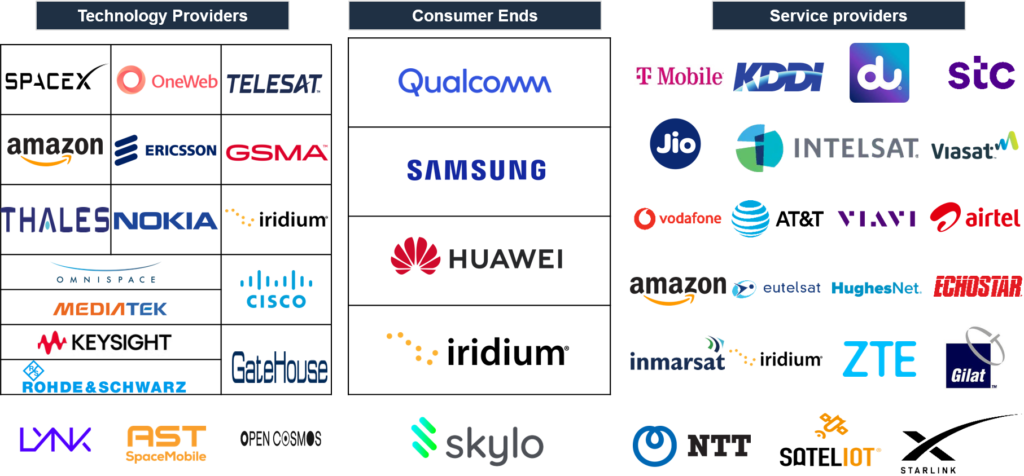
Figure 5: 5G NTN Prominent Key Players
The technology providers include companies that are working on the development of new technology solutions. Service providers include companies that offer internet or other services related to 5G NTN. Consumer device providers provide products for the consumer end.
| Company | Details |
| Iridium | In January 2024, Iridium announced Project Stardust, which is the evolution of its direct-to-device (D2D) strategy with 3GPP 5G standards based on Narrowband-Internet of Things (NB-IoT) Non-Terrestrial Network (NB-NTN) service development. |
| AST SpaceMobile | In September 2023, AST SpaceMobile marked the first ever 5G connection between an unmodified smartphone and a satellite placed over a satellite call over 5G by using a Galaxy S22. |
| Viavi | In August 2023, Viavi Solutions provided a base station and end-to-end testing that supports NTN and HAPs. VIAVI’s TM500 and TeraVM test platforms validate the conformance, performance, and reliability of gNodeBs and entire networks under the unique service link conditions of NTN and HAP networks. |
| SpaceX | In April 2023, SpaceX launched a satellite in LEO to operate on the 5G cellular standard. The satellite is also known as “The GroundBreaker,” where the first constellation of over 250 spacecraft, named Sateliot_0, has been developed, weighing up to 22 pounds (10 kilograms). |
Table 1: Market Activities of the Prominent Key Players of 5G NTN
Conclusion
The implementation of 5G Non-terrestrial Networks has great potential for the future of wireless communication by providing a low latency, high scalability, and large coverage. By leveraging the non-terrestrial user equipment, 5G NTN helps connect the digital divide, enhancing the network’s reliability and accessibility of high-quality communication services.
Space-based Internet of Things can be integrated into 5G NTN by using satellites as part of the network infrastructure. Satellites enable global coverage and low-latency connectivity for IoT devices, enhancing 5G’s reach to remote or challenging environments. This integration ensures high-speed data transmission and scalability, which is crucial for diverse IoT applications.
Further, research has been conducted on the 6G non-terrestrial network, focusing on the critical requirements for deploying 6G in non-terrestrial networks. These requirements are terahertz (THz) communications and optical wireless communication (OWC) for achieving the multi-gigabits-per-second capacity required by 6G applications. Additionally, intelligent reflecting surfaces (IRS) are being studied to control the signal propagation delay and use cloudification and network/service orchestration/management for network flexibility.


